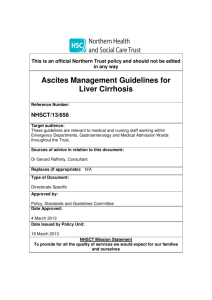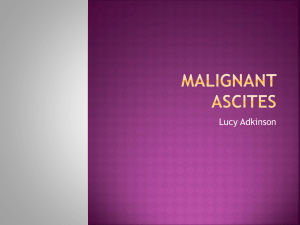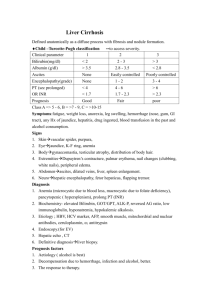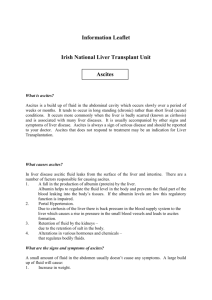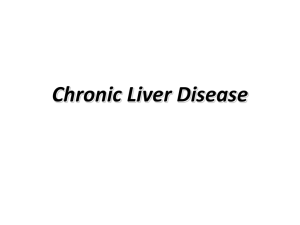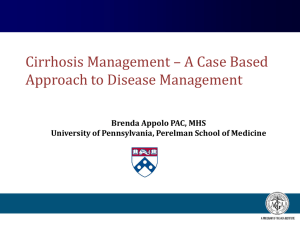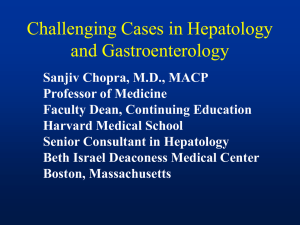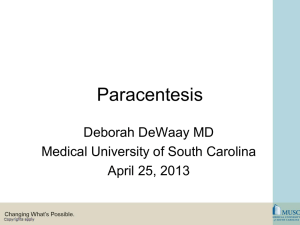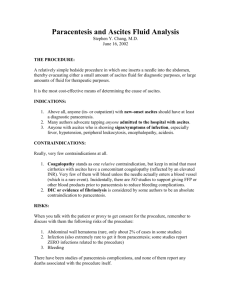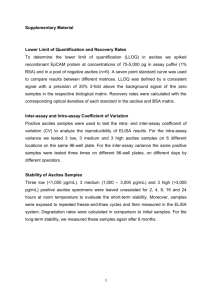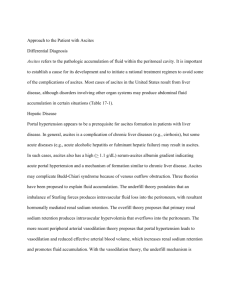Ascites Case Writeup/Pres
advertisement
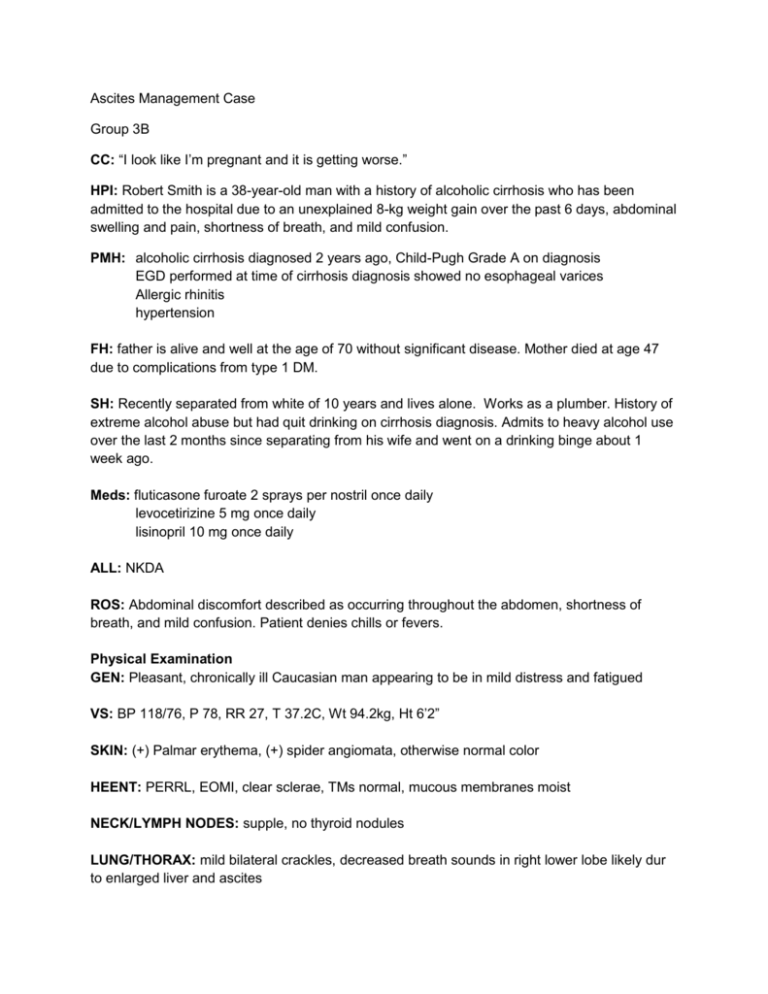
Ascites Management Case Group 3B CC: “I look like I’m pregnant and it is getting worse.” HPI: Robert Smith is a 38-year-old man with a history of alcoholic cirrhosis who has been admitted to the hospital due to an unexplained 8-kg weight gain over the past 6 days, abdominal swelling and pain, shortness of breath, and mild confusion. PMH: alcoholic cirrhosis diagnosed 2 years ago, Child-Pugh Grade A on diagnosis EGD performed at time of cirrhosis diagnosis showed no esophageal varices Allergic rhinitis hypertension FH: father is alive and well at the age of 70 without significant disease. Mother died at age 47 due to complications from type 1 DM. SH: Recently separated from white of 10 years and lives alone. Works as a plumber. History of extreme alcohol abuse but had quit drinking on cirrhosis diagnosis. Admits to heavy alcohol use over the last 2 months since separating from his wife and went on a drinking binge about 1 week ago. Meds: fluticasone furoate 2 sprays per nostril once daily levocetirizine 5 mg once daily lisinopril 10 mg once daily ALL: NKDA ROS: Abdominal discomfort described as occurring throughout the abdomen, shortness of breath, and mild confusion. Patient denies chills or fevers. Physical Examination GEN: Pleasant, chronically ill Caucasian man appearing to be in mild distress and fatigued VS: BP 118/76, P 78, RR 27, T 37.2C, Wt 94.2kg, Ht 6’2” SKIN: (+) Palmar erythema, (+) spider angiomata, otherwise normal color HEENT: PERRL, EOMI, clear sclerae, TMs normal, mucous membranes moist NECK/LYMPH NODES: supple, no thyroid nodules LUNG/THORAX: mild bilateral crackles, decreased breath sounds in right lower lobe likely dur to enlarged liver and ascites BREASTS: nontender without masses CV: RRR, S1 and S2 are normal, no MRG ABD: bulging, tender abdomen, heptaomegaly, (+) fluid wave, bowel sounds normal GENIT/RECT: guaiac negative MS/EXT: 1+ pitting edema in both LE, palmar erythema, no clubbing or cyanosis NEURO: mildly confused, forgetful, A&O x 2 (oriented to person and time but does not know at which hospital he is) LABS: Na 135mEq/L Hgb 16g/dL AST 88IU/L Ca 8.5mg/dL K 4.1 mEq/L Hct 47% ALT 116 IU/L Mg 1.9mEq/L Cl 98mEq/L Plt 81 x 103/mm3 LDH 167IU/L Phos 3.5mg/dL CO2 30mEq/L WBC 6.2 x 103/mm3 T. bili 2.2mg/dL TSH 3.6mIU/L BUN 19mg/dL PT 14.3 sec D. bili 0.7mg/dL NH3 94 mcg/dL SCr 0.7mg/dL PTT 47 sec T. prot 7.3g/dL HIV (-) Glu 102mg/dL INR 1.33 Alb 2.8 g/dL Assessment: Worsening cirrhosis; now presenting with ascites and acute encephalopathy Perform diagnostic and therapeutic paracentesis R/O spontaneous bacterial peritonitis (SBP) Clinical Course: After removal of 5 L of fluid by paracentesis, an analysis of the fluid was performed. The analysis reported a protein level of 1.4g/dL, PMN 140 cellls/mm3, and SAAG 1.4g/dL. The culture results were negative after 3 days. The patient’’s mental status began to improve after paracentesis and the administration of lactulose 30mL po twice daily. Once stabilized, an EGD was performed, which showed small esophageal varicies. Problem List: 1. Ascites 2. Hepatic encephalopathy Ascites S: RS is a 38 year old male admitted for an unexplained 8kg weight gain over the past 6 days, abdominal swelling and pain, shortness of breath, and mild confusion. He was diagnosed with alcoholic cirrhosis 2 years ago, with a Child-Pugh Grade A on diagnosis. He also has allergic rhinitis and hypertension. Family history is non-contributory. He has a history of heavy alcohol abuse, but quit drinking on cirrhosis diagnosis. He admits to heavy alcohol use over the past 2 months because he separate from his wife of 10 years. He went on a drinking binge about a week ago. O: Medications: Fluticasone furoate 2 sprays per nostril once daily Levocetirizine 5 mg once daily Lisinopril 10 mg once daily NKDA ROS: abdominal discomfort described as occurring throughout the abdomen, shortness of breath, and mild confusion. Patient denies chills or fevers. GEN: pleasant, chronically ill Caucasian man appearing to be in mild distress and fatigued VS: BP 118/76, P 78, R 27, T37.2C, Wt 94.2kg, Ht 6’2” SKIN: (+) Palmar erythema, (+) spider angiomata, otherwise normal color HEENT: PERRL, EOMI, clear sclerae, TMs normal, mucous membranes moist LUNG/THORAX: mild bilateral crackles, decreased breath sounds in right lower lobe likely due to enlarged liver and ascites CV: RRR, S1 and S2 are normal, no MRG ABD: bulging, tender abdomen, hepatomegaly, (+) fluid wave, bowel sounds normal MS/EXT: 1+ pitting edema in both LE, palmar erythema, no clubbing or cyanosis NEURO: mildly confused, forgetful, A&O x 2 (oriented to person and time but does not know at which hospital he is) LABS: Na 135mEq/L Hgb 16g/dL AST 88IU/L Ca 8.5mg/dL K 4.1 mEq/L Hct 47% ALT 116 IU/L Mg 1.9mEq/L Cl 98mEq/L Plt 81 x 103/mm3 LDH 167IU/L Phos 3.5mg/dL CO2 30mEq/L WBC 6.2 x 103/mm3 T. bili 2.2mg/dL TSH 3.6mIU/L BUN 19mg/dL PT 14.3 sec D. bili 0.7mg/dL NH3 94 mcg/dL SCr 0.7mg/dL PTT 47 sec T. prot 7.3g/dL HIV (-) Glu 102mg/dL INR 1.33 Alb 2.8 g/dL Clinical Course: After removal of 5 L of fluid by paracentesis, an analysis of the fluid was performed. The analysis reported a protein level of 1.4g/dL, PMN 140 cellls/mm3, and SAAG 1.4g/dL. The culture results were negative after 3 days. The patient’’s mental status began to improve after paracentesis and the administration of lactulose 30mL po twice daily. Once stabilized, an EGD was performed, which showed small esophageal varicies. A: This patient is suffering from ascites,which is fluid accumulation in the abdomen resulting from liver cirrhosis and portal hypertension. The patients extensive alcohol abuse lead to a diagnosis of cirrhosis 2 years ago, which has now progressed to portal hyptertension and ascites. Alcohol abuse causes fibrosis of the parenchyma cells of the liver leading to hepatic injury, fibrosis and nodular regeneration. This leads to obstruction of blood flow across the liver causing portal hypertension. As a result of uncontrolled portal hypertension, there is peripheral arterial vasodilation and a drop in systemic arterial pressure. This activates RAAS, ADH, and the sympathetic nervous system to increase renal water and sodium retention. The water and sodium retention causes lymphatic fluid to accumulate in the abdomen, which is ascites. Our patient was presenting with the signs and symptoms of ascites, including shortness of breath, an unexplained 8kg weight gain over the past 6 days, abdominal pain and swelling, and mild confusion. Although the fluid was removed from his abdomen when 5L of fluid were removed during paracentesis, the patient is still at risk of developing ascites again because of his underlying liver failure. There are preventative measures that can be done to slow ascites, but a liver transplant is the only way to prevent future episodes. Our patient is also presenting with small esophageal varicies, which are a complication of ascites. Esophageal varicies are channels that develop between higher pressure portal system veins and lower pressure systemic veins. This lead to bulging and ballooning veins in the esophagus. Esophageal varicies are the leading cause of death in cirrhosis because they have the potential to rupture and bleed. He is at high risk for variceal rupture and bleeding. Treatment should focus on the prevention of the progression of ascites and the prevention of variceal bleeding. Goals of therapy are to prevent variceal bleeding, decrease portal hypertension, improve breathing, and prevent further complications such as renal failure. The Child-Pugh scale is a system that is used to evaluate the progression of liver disease by looking at total bilirubin, serum albumin, PT INR, ascites, and hepatic encephalopahty. Our patient has a score of 10, class C, which means he has a 45% change of one year survival and a 35% chance of a two year survival. RS is in liver failure.2 The management and prevention of acites should include avoiding alcohol consumption. Continued alcohol consumption will further progress his liver failure. Sodium consumption should be restricted to 2000mg per day to help mobile ascites. Medications used to delay future ascites are diuretics, specifically spironolactone and furosemide, which should be used in combination. Spironolactone is a potassium sparing diuretic that antagonizes the elevated aldosterone and causes increased sodium and water excretion. It should be initiated at 100mg initially with a maximum dose of 400mg. Furosemide is a loop diuretic that minimizes hyperkalemia and enhances diuresis. It should be initiated at 40mg with a maximum dose of 160mg. The recommended furosemide to spironolactone ratio is 40:100. The recommended diuresis is 1/2kg (1L of fluid = 1kg), however, for patients with lower extremity edema, more aggressive diuresis can be pursued, such as 1L per day. The doses of spironolactone and furosmide can be titired toa chieved the desired diueisis. If diuretics are inffective, paracentesis or TIPS can be performed. However, liver transplantation is the only way to prevent ascites for occuring. Treatment of esophageal varices includes primary prevention by using non-selective beta blockers to control portal hypertension and prevent rupture and bleeding of varicies.Nonselective beta blockers are recommended for patients with small varices with no history of bleeding Propranolol is initially doses as 20mg twice daily, and it can be adjusted to the maximum tolerated dose. Nadolol is initailly dosed as 40mg once daily, and it can be dosed to the maximum tolerated effect. The goal is to reduce heart rate to 55 to 60 beats per minute. Secondary prophylaxis involves endoscoping band ligation.3 P: -Spironolactone 100mg po once daily -Furosemide 40mg po once daily Monitor weight daily Monitor SCr, electrolytes, BP, edemda and asities weekly?? Consel: Take diuretics in the morning because of increased urination, may cause dizziness, avoid NSAIDS. -Propranolol 20mg po twice daily Monitor HR daily Counsel: May cause dizziness or fatigue -Stop drinking-encourage enrolling in support programs (AA) -Refer to psychologist for therapy on separation from wife -Restrict sodium intake to 2000mg per day Hepatic encephalopathy: S: Recently separated from wife and lives alone. Diagnosed with alcoholic cirrohsis 2 years ago. Family history is non-contributory. Admits to heavy alcohol use over the past 2 months since they separated and went on a drinking binge about one week ago. Reports mild confusion, distress and fatigue. He is oriented to person and time, but not to the hospital he is at. O: At time of cirrohsis diagnosis, RS was a Child-Pugh score A, and upon endoscopy was negative for varices. NKDA. GEN: pleasant, chronically ill Caucasian man appearing to be in mild distress and fatigued VS: BP 118/76, P 78, R 27, T37.2C, Wt 94.2kg, Ht 6’2” SKIN: (+) Palmar erythema, (+) spider angiomata, otherwise normal color HEENT: PERRL, EOMI, clear sclerae, TMs normal, mucous membranes moist LUNG/THORAX: mild bilateral crackles, decreased breath sounds in right lower lobe likely due to enlarged liver and ascite ABD: bulging, tender abdomen, hepatomegaly, (+) fluid wave, bowel sounds normal MS/EXT: 1+ pitting edema in both LE, palmar erythema, no clubbing or cyanosis NEURO: mildly confused, forgetful, A&O x 2 (oriented to person and time but does not know at which hospital he is) LABS: Na 135mEq/L Hgb 16g/dL AST 88IU/L Ca 8.5mg/dL K 4.1 mEq/L Hct 47% ALT 116 IU/L Mg 1.9mEq/L Cl 98mEq/L Plt 81 x 103/mm3 LDH 167IU/L Phos 3.5mg/dL CO2 30mEq/L WBC 6.2 x 103/mm3 T. bili 2.2mg/dL TSH 3.6mIU/L BUN 19mg/dL PT 14.3 sec D. bili 0.7mg/dL NH3 94 mcg/dL SCr 0.7mg/dL PTT 47 sec T. prot 7.3g/dL HIV (-) Glu 102mg/dL INR 1.33 Alb 2.8 g/dL Clinical Course: After removal of 5 L of fluid by paracentesis, an analysis of the fluid was performed. The analysis reported a protein level of 1.4g/dL, PMN 140 cellls/mm3, and SAAG 1.4g/dL. The culture results were negative after 3 days. The patient’’s mental status began to improve after paracentesis and the administration of lactulose 30mL po twice daily. A: Patient RS presents with hepatic encephalopathy as supported by the usual signs and symptoms. HE is secondary to the ascities RS is currently experiencing. Since the liver is already has diminished function(cirrotic for 2 years) and excess fluid in the peritoneal cavitity (ascities), toxins and nutrients diffuse by osmosis into the blood stream, crossing the BBB into the CNS where they have negative effects. These effects include fatigue and diminished mental status (A & O x 2), with recent changes in behavior status (alcohol consumption after 10 years of sobriety; binge drinking last week due to separation to his wife). Elevated ammonia levels (94 mcg/dl) are also suggestive of hepatic encephalopathy. This disease state is directly tied to our patients ascites and cirrhosis and is exacerbating the symptoms. Calculated values: based on the criteria outlined in dipiero,the patient has grade 1-2 hepatic encephalopathy. He is fatigued, confused, mildly distressed, and is only alert and oriented to 2 degrees (not place). Upon diagnosis 2 years ago, RS’s Child Pugh score was A. Today, according to Child Pugh, he has progressed to a C with worsening ascites and HE. The goal of therapy is to ultimately return mental status back to baseline. Other outcomes are the clinical benefits of reducing ammonia levels, eliminating drugs that cause CNS depression, preserving remaining liver function, preventing future hospitalizations, and limiting the amount of protein in the diet. First, treat the cause of the HE. Seeing that the cirrotic liver has elevated AST/ALT’s is actually a good sign. It shows the liver is still functional although injured. Normal values of these liver enzymes would indicate no residual liver function. Environmental factors that are contributing to RS’s HE is his alcohol consumption and excess intake of dietary proteins. Educate the patient on the importance of sobriety in alcoholic cirrohsis, and refer to AA if necessary. Educate the need for a low protein diet . The best course of action, pharmaceutically, is to choose lactulose as the first line agent. According to the guidelines, the dose of lactulose is individualized at induction to each patient, and titrated to produce 2-4 soft, loose stools per day. This poorly absorbed sugar raises the pH of the colon and ultimately increases the absorption of the ammonia, leading to less CNS effects. For maintenance and prophylaxis of HE, a dose of 30 ml by mouth every 12 hours should be used as a guideline, individualized again to reach a goal of 2-4 soft/loose stools a day. Rifaximin is another option for RS. A synthetic antibiotic, Rifaximin kills the bacteria of the colon and therefore inhibits the absorption of ammonia. This is effective in patients who are refractory to lactulose, or in diabetics. It can also be used as adjunct therapy if lactulose alone isn’t getting the job done. Draw backs to this therapy are out-of-pocket costs, side effect profile, and increasing resistance. To ensure reversal of HE effects, assessment of the grade of encephalopathy needs to be taken. It can be measured by EEG, psychological testing, and mental status changing measured by the SF-36. Monitoring the serum ammonium levels as well as other toxins in the blood to ensure reversal is pertinent. P: Quit Drinking! Give preliminary SF-36 Prescribe lactulose 30 ml po twice daily or until experiencing 2-4 soft loose stools per day Educate on nutrition (limit dietary protein) Educate on medication adherence Side effects of lactulose bloating gas n/v/d Monitor: Serum NH3, Follow up in 2-3 weeks; redo SF-36 References 1. Runnyon BA. Management of Adult Patients with Ascites due to Cirrhosis: Update. AASLD Practice Guideline. Hepatology. 2013. 2. Pugh RNH, Murray-Lyon IM, Dawson JL, et al. Transection of the oesophagus for bleeding oesophagus varices. Br J Surg 1973;60: 646–649. 3. Wright AS, Rikkers LF. Current management of portal hypertension. J Gastrointest Surg 2005;9:992–1005.
